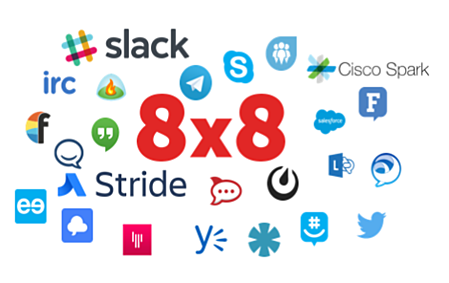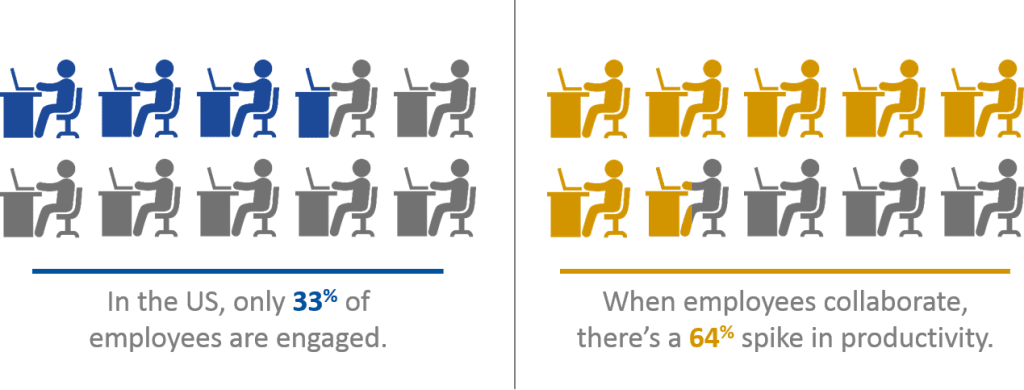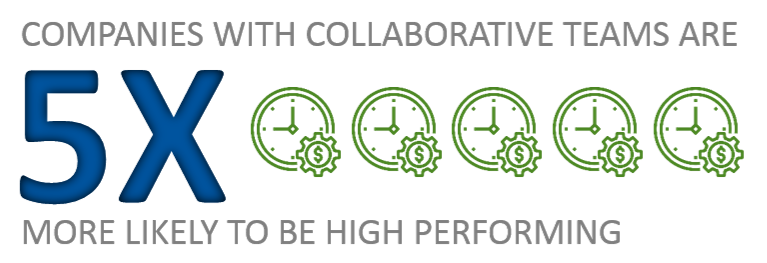Increase Your Company’s Productivity By 5X

Using team collaboration to increase productivity, innovation, retention, and more.
These days, businesses are moving quickly. Dozens of projects are in progress at once, employees are spread out nation-wide, and some employees are remote. How do you keep your employees engaged, innovative, and happy? The answer is simpler than you might think. Team collaboration is a simple tool you can provide to your employees that can solve many of your management problems.

What does team collaboration mean? Team members collaborate with each other day in and day out. In this case, team collaboration is referring to using software that allows ad-hoc, persistent, asynchronous team communications with the ability for users to create private or public workspaces to meet their collaborative needs. You’ve probably already heard of a lot of team collaboration software, whether you know it or not. A common tool is Slack, which provides a hub for project discussions, important documents, multiple channels of communication, and a search functionality to hunt through all of these things for reference. There are a lot of other team collaboration tools out there, too. With Skype, you can connect to your project management team working in Plano. With Salesforce Chatter, you can connect with your sales team. That being said, every company and team is unique and their collaboration needs are too. That means that any type of collaboration tool can be a good fit for any type of company, and you can use any collaboration tool for any type of team.
So, how exactly does team collaboration increase engagement, productivity, innovation, retention, and more? Really, the answer is in a lot of ways.
Boosting Engagement
While all benefits of team collaboration are pivotal, the boost in engagement is one of the most talked about. Employee engagement is described as “those who feel involved in, enthusiastic about, and committed to their work and workplace”. Recent studies have shown that:
- Only 33% of employees in the US are engaged. That means that two-thirds of your employees are unengaged.
- 85% of employees blame lack of collaboration for workplace failures that occur.
- When employees work on a collaborative task, there is a 64% spike in productivity.
Companies experiencing high rates of unengaged employees have found the antidote- and that is to provide collaborative tools, and emphasize collaboration as part of their culture.

Team collaboration increases engagement by providing a space for employees to continuously meet and communicate within. Whether they are in office or out, focusing deeply on a project or trying to get started, employees can easily reach out and interact with each other. Using a team collaboration tool sets the expectation that employees need to check in and be responsive with their co-workers. Employees also know that they can always reach out for help or discussion, which provides significant motivation on any given task. The expectation that your team is available to you in multiple forums increases engagement significantly.
Increasing Productivity
A variety of studies have found that professional collaboration positively impacts productivity. A Stanford study found that even just the perception of collaboration can improve performance. How much? Similar studies have found that companies that promoted collaborative working were 5 times as likely to be high performing.

So how does this occur? Research shows that 20-35% of value-added collaborations come from only 3-5% of employees. These employees are referred to as “Extra Milers”, and formal communications such as meetings, emails, and presentations tend to bog down their workday. How? Because they have to interrupt their productivity to communicate formally with other team members.
Team collaboration flips the script for Extra Milers:
- Instead of stopping their work to communicate with coworkers, they’re able to use informal chats and ad-hoc communications.
- When they have a question, they can quickly reach out and receive a response via chat.
- They can engage in these communications when they have a moment, as opposed to having interruptions when they are deep in concentration.
- If a project requires an ongoing conversation, they can create and then pop in and out of a project specific room to ask more questions from a group of colleagues, or to reference a previous conversation.
Some companies have found a 25% increase in individual productivity when they have implemented tools that encourage peer-to-peer collaboration.
Encouraging Innovation
Collaboration can be difficult when there are a lot of different personalities involved, but the end result is often innovation. The multiple personalities and ideas involved often co-invent to create a bigger and better concept. Team collaboration encourages employees to continuously engage and work together more, helping them to generate dynamic innovative ideas. Those ideas are stored in chats that can be searched, rooms that can be returned to again and again, and in files that are never misplaced. Effective collaboration, encouraged by your company with team collaboration platforms, can generate concepts that are 58% better when tested by consumers.
Better Hiring and Retention
Because collaboration is so beneficial to companies, the ability to collaborate effectively is a highly sought after trait. In fact, 75% of CEOs view collaboration as the most employee valued trait. That being said, for employees to be effective collaborators, managers have to provide them the tools they need to succeed. A collaborative culture with effective tools like collaboration platforms helps to attract top talent, as many employees “relish the opportunity to engage, interact, and learn from senior management”. By creating a collaborative culture for your team or company, you can attract the best employees, who will know that their new team will be there for them on every project. And it will make your hiring manager happy, too.
Once you have your new hires in place, team collaboration can help you retain your star employees. The best thing about employee engagement is that it equates happier, more fulfilled employees. Team collaboration sets the foundation for a more open culture within the workplace.
Unifying Remote and In-Office Workers
In a recent study, it was found that 85% of workers want to feel closer to their remote colleagues. For a remote workforce to succeed, it’s pivotal that they have the proper tools to communicate, stay productive, and to feel part of the team. While traditional communication tools, such as phone and email, are pivotal, team collaboration software is the tool that allows all workers to feel closer and more interactive.
Team collaboration is important for teams with remote workers because it helps to ensure everyone is in the loop, and that, through team collaboration’s additional modes of communication, employees can increase clarity and context. In short, team collaboration helps fill in the communication gaps that can hurt productivity and morale for teams with remote workers.
Standalone Team Collaboration vs. Integrated Team Collaboration
Team collaboration software can be used as a standalone platform, such as when a company uses Slack or Skype in addition to their other communication tools. However, to get the full benefit from team collaboration (and even take it to the next level) many companies are selecting a communications system that integrates with their team collaboration system. A handful of communications providers deliver solutions that integrate with team collaboration software. Vertical works with their customers to help select the best solution and collaboration integration for their unique needs. For companies that are already using Unified Communications (UC), team collaboration is just one more mode. There are several benefits to integrating your team collaboration tool with your phone provider and UC:
- Team collaboration integrations mean that all of your company’s communications are standardized. That means that your employees will only need training on one platform.
- Integrated Team collaboration breaks down information and communication silos. Team collaboration provides persistent workspaces company-wide through a host of communication modes, which means that not only is the record of the conversation searchable, but also files. This information can be shared across teams and divisions.
- With integrated team collaboration, employees never have to leave your communications system to communicate. Native collaboration within your communications system means that every user has access through the Unified Communications client.
- Team collaboration integrations can be integrated with other communication system integrations, such as email, calendar, CRM, and task managers.Integrating team collaboration systems with your company’s other apps helps provide a single-pane-of-glass experience for employees.
Your Team Collaboration Options
When it comes to team collaboration, you have options. Whether you need to implement team collaboration at your company for the first time, want to stick with your current team collaboration platform, or want to integrate your current platform or a new platform with your communications system, Vertical can help. Vertical Communications will architect the best implementation for your 8×8 services and will seamlessly integrate your collaboration tools. Combining Vertical’s award-winning design, install, and service with 8×8’s industry-leading UCaaS and CCaaS solution means you can set up your team collaboration exactly to your unique business needs. V8 delivers a super-charged cloud solution unlike anything else on the market.



